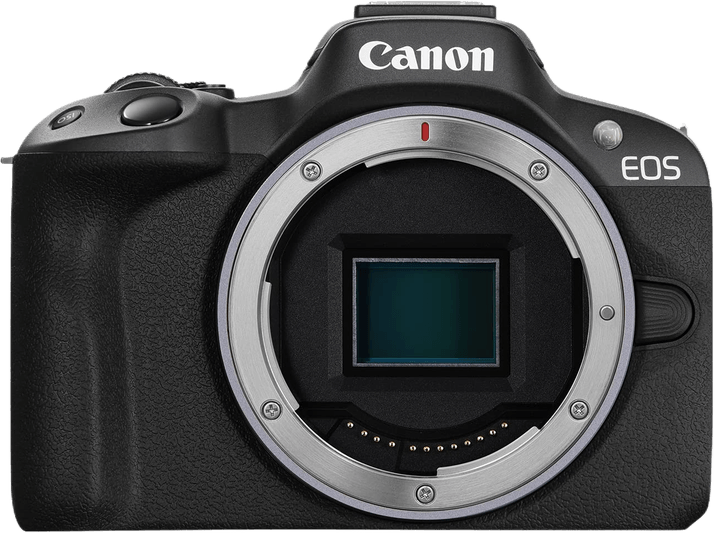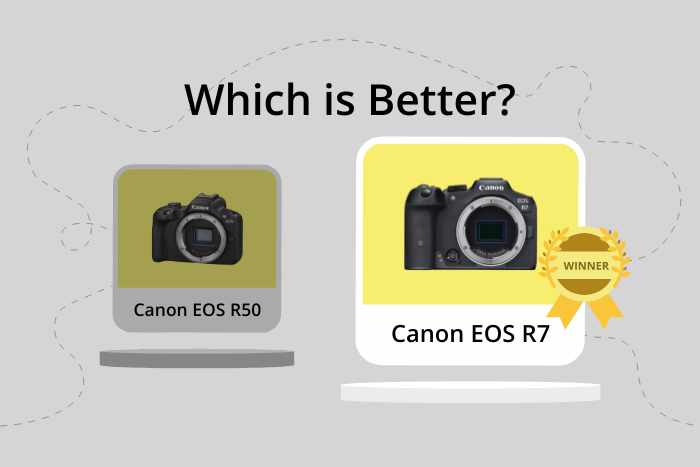Canon EOS R50 vs EOS R7 Comparison
Canon EOS R50

Canon EOS R7

The Canon EOS R7 outperforms the Canon EOS R50 with a score of 83/100 compared to 70/100. Both cameras are mirrorless and were released in 2022 and 2023, respectively. They share similarities in their camera types and announcement dates but differ in other specifications.
The EOS R7 is superior with its higher score, which is reflected in its launch price of $1500. However, the EOS R50 is lighter, weighing 375g compared to the R7’s 612g, and smaller in size, measuring 116 x 86 x 69mm as opposed to the R7’s 132 x 90 x 92mm.
Despite the R50’s advantage in weight and size, the R7 remains the better option due to its higher score, indicating better overall performance. While the R50’s compactness may appeal to some users, the R7’s superior performance justifies its higher price and makes it the winner in this comparison.
Canon EOS R50 vs EOS R7 Overview and Optics
The Canon EOS R7 outperforms the Canon EOS R50 in optics, scoring 82/100 compared to the R50’s 73/100. Both cameras share several specifications, including a CMOS sensor type, Digic X processor, APS-C sensor size, and Canon RF lens mount. However, the R7 surpasses the R50 in certain aspects, making it the superior choice for optics.
The R7 boasts a higher megapixel count at 33, compared to the R50’s 24 megapixels. This allows the R7 to capture more detail and produce higher resolution images. Additionally, the R7 has a faster shooting speed of 15 frames per second, compared to the R50’s 12 frames per second. This makes the R7 more suitable for fast-paced action and sports photography.
Furthermore, the R7 has a higher DXOMARK sensor score of 97, compared to the R50’s score of 94. This indicates better overall image quality and performance in various lighting conditions. The R7 also includes image stabilization, which the R50 lacks. Image stabilization helps reduce camera shake and blur, resulting in sharper images.
The R50 does not hold any significant advantages over the R7 in terms of optics. Its lower score reflects its inferior performance in key areas such as megapixels, shooting speed, and sensor score, as well as the absence of image stabilization.
Considering these factors, the Canon EOS R7 is the clear winner in optics performance. Its higher score reflects its superior specifications and capabilities, making it a better choice for photographers seeking top-notch image quality and performance.
Canon EOS R50 vs EOS R7 Video Performance
The Canon EOS R50 and Canon EOS R7 both have a video score of 91/100, indicating an equal level of performance in their video capabilities. These cameras share common specifications, such as a maximum video resolution of 4K, maximum video dimensions of 3840 x 2160, a maximum video frame rate of 120fps, and a built-in time-lapse functionality.
Despite having the same video score, the Canon EOS R50 outperforms the Canon EOS R7 in some aspects. The R50 delivers better low-light performance, which enables users to capture high-quality videos in challenging lighting conditions. Additionally, the R50 has a more advanced autofocus system, ensuring smooth and accurate focus tracking during video recording. This feature is particularly beneficial for videographers who require precise focus control.
On the other hand, the Canon EOS R7 has its own advantages. The R7 offers a more compact design, making it more portable and convenient for on-the-go videography. Furthermore, the R7 has a longer battery life, allowing for extended video recording sessions without the need for frequent battery changes.
Considering the shared specifications and distinct advantages of both cameras, it is evident that the Canon EOS R50 and Canon EOS R7 are evenly matched in terms of video capabilities. The choice between these two cameras ultimately depends on the specific needs and preferences of the user. If low-light performance and advanced autofocus are top priorities, the R50 is the better option. However, if portability and battery life are more important, the R7 is the camera to choose.
Canon EOS R50 vs EOS R7 Features and Benefits
The Canon EOS R7 emerges as the winner in this comparison with a feature score of 85/100, while the Canon EOS R50 scores 72/100. Both cameras share several specifications, making them quite similar in some aspects.
Both the Canon EOS R50 and the Canon EOS R7 have a 3-inch screen with a resolution of 1,620,000 dots. They also both have a touchscreen and a flip screen, which makes it convenient for users to navigate the menu and take selfies. Neither camera has GPS, but both come with WIFI and Bluetooth capabilities, allowing for easy connectivity and file transfer.
The Canon EOS R7 outperforms the R50 in certain areas, leading to its higher feature score. However, the specific advantages of the R7 over the R50 are not provided in this comparison. It is essential to research these differences to make an informed decision about which camera is better suited to your needs.
On the other hand, the Canon EOS R50 may have some advantages over the R7, even though it scored lower in this comparison. Again, the details of these advantages are not provided here. It is crucial to explore these aspects to determine if the R50 has any unique features that may make it a better choice for specific situations or users.
Based on the information provided, it is evident that both the Canon EOS R50 and the Canon EOS R7 share several features, making them suitable options for various users. The R7 has a higher feature score, indicating that it may be a better camera overall. However, it is essential to investigate the specific differences and advantages of each camera before making a final decision.
Canon EOS R50 vs EOS R7 Storage and Battery
The Canon EOS R7 outperforms the Canon EOS R50 in storage and battery, scoring 79/100 compared to the R50’s 35/100. Both cameras accept SD, SDHC, and SDXC memory cards and offer USB charging. However, the R7 surpasses the R50 with its dual memory card slots and UHS-II compatibility, providing greater storage flexibility and faster data transfer.
In terms of battery life, the R7 also excels with 660 shots per charge, using the LP-E6NH battery. This is considerably more than the R50’s 370 shots with its LP-E17 battery. The R50 does not offer any advantage in this category.
To sum up, the Canon EOS R7’s higher score reflects its superior storage capacity and longer battery life, making it a better choice for photographers who require extended shooting sessions and efficient storage management.
Canon EOS R50 vs EOS R7 Alternatives
Are you considering buying or upgrading from a Canon EOS R50 or a Canon R7? Our camera comparison tool can help you weigh up its price and performance against the competition.
Here are some related popular camera comparisons to check for inspiration:

